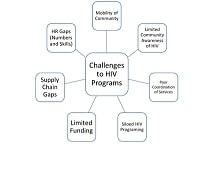Alignment of HIV Program Performance to HIV Priorities in North Eastern Region of Uganda

Abstract:
The
purpose of this study was to assess the alignment of HIV/AIDS programming in North
Eastern Uganda to the current program goals of ending HIV as a public health
threat in this region by 2030, achieving 95-95-95, and eliminating HIV/AIDS
stigma in the community. The study found that the state of program
implementation is not well aligned to and is not on track to achieve these program
goals. The region had not achieved the desired level of performance in any of
the 95 targets. The first 95 (proportion of people living with HIV who their
HIV status) was found to be at approximately 75%. The second 95 (proportion of
those living with HIV who are on Anti-Retroviral Therapy - ART) was found to be
approximately 63% and the third 95 (Viral Load Suppression among those on
treatment) was at approximately 70%. This made the cascade 75-63-70, which was
significantly below the 95-95-95 targets. 36% percent of the people living with
HIV report feeling significant levels of stigma, which is far from the target
of 0%. The study documented the key challenges that are hindering progress
towards the current program goals. These include limited funding, siloed
programming, insufficient coordination, lack of prioritization of HIV programs
by local leaders, frequent stockouts of essential commodities, shortage of
personnel, and insufficient skills among some of the existing personnel. Urgent
action is needed by all stakeholders to revamp HIV programming in the region
and put it on track to achieve the desired goals.
References:
[1] CDC,
MMWR, June 5, 1981. https://stacks.cdc.gov/view/cdc/1261
[2] UNAIDS
2020: Forty years into the HIV epidemic, AIDS remains the leading cause of
death of women of reproductive age — UNAIDS calls for bold action https://www.unaids.org/en/resources/presscentre/pressreleaseandstatementarchive/2020/march/20200305_weve-got-the-power
[3] WHO
2017, President of Uganda Launches Fast Track Initiative Ending HIV AIDS in
Uganda by 2030 https://www.afro.who.int/news/president-uganda-launches-fast-track-initiative-ending-hiv-aids-uganda-2030
[4] Ssenkaaba
John - 2015: The Changing Livelihood of the Karamoja people of North Eastern
Uganda and Its Impact on the Survival of Their Traditional Gender Roles. – The
Artic University of Norway. https://munin.uit.no/bitstream/handle/10037/7782/thesis.pdf?sequence=2
[5] Emunyu
Ocan Charles and Ocan Charles - Pastoral resources and conflicts in
North-Eastern Uganda: the Karimojong case - Nomadic Peoples - https://www.jstor.org/stable/43124077
[6] ICAP
Columbia University, 2022, Uganda Summary Sheet 2020-2021 PHIA Project:
Retrieved from https://phia.icap.columbia.edu/uganda-summary-sheet-2020-2021/
[7] AMICAALL,
2016, Baseline survey on HIV/AIDs Among Young People in Karamoja sub-region
December 2016.
[8] UNAIDS
Indicator Registry: https://indicatorregistry.unaids.org/indicator/people-living-hiv-who-know-their-status
[9] UNFPA
2018: Leaving no one behind in Karamoja, Issue brief 07, August 2018. https://uganda.unfpa.org/sites/default/files/pub
pdf/Issue%20Brief%207.%20Leaving%20no%20one%20behind%20in%20Karamoja.pdf
[10] UNAIDS
Understanding FAST-TRACK 95:95:95 https://www.unaids.org/sites/default/files/media_asset/201506_JC2743_Understanding_FastTrack_en.pdf
[11] Ministry
of Health et al, 2019, Uganda Population-Based Impact Assessment - UPHIA
2016-2017 Final Report.
[12] Ssebunya
Rogers, N., Rhoda K Wanyenze, Leticia Namale, Heather Lukolyo, Grace P Kisitu,
Patricia Nahirya-Ntege, Adeodata Kekitiinwa, 2018, Prevalence and correlates of
HIV testing among adolescents 10-19 years in a post-conflict pastoralist
community of Karamoja region, Uganda. https://bmcpublichealth.biomedcentral.com/articles/10.1186/s12889-018-5544-0
[13] NAFOPHANU,
2019, People Living with HIV Stigma Index Survey 2019, Uganda Country
Assessment. https://www.stigmaindex.org/wpcontent/uploads/2019/11/PLHIV-Stigma-Index-Report-Uganda-2019.pdf
[14] Ssenkaaba
John - 2015: The Changing Livelihood of the Karamoja people of North Eastern
Uganda and Its Impact on the Survival of Their Traditional Gender Roles. – The
Artic University of Norway. https://munin.uit.no/bitstream/handle/10037/7782/thesis.pdf?sequence=2
[15] Uganda
AIDS Commission, 2017: The Uganda HIV/AIDS Country Progress Report July
2016-June 2017 https://www.unaids.org/sites/default/files/country/documents/UGA_2018_countryreport.pdf
AMICAALL, 2016, Baseline survey on HIV/AIDs Among Young People in Karamoja sub-region December 2016

